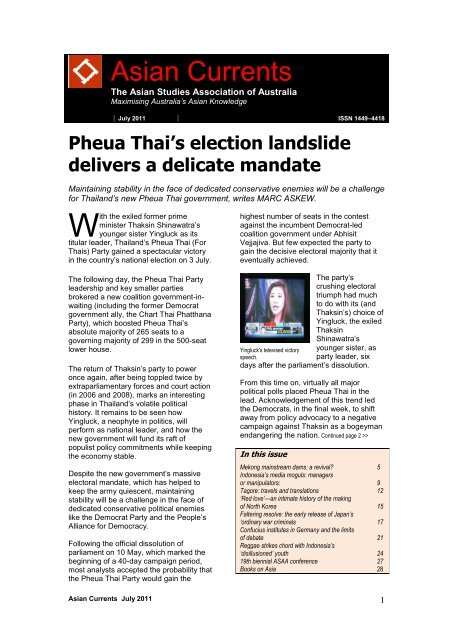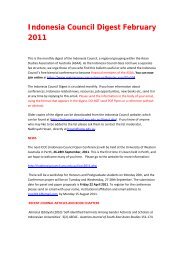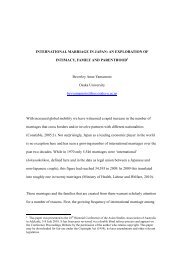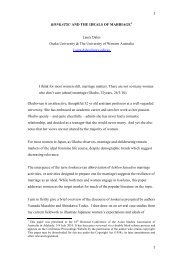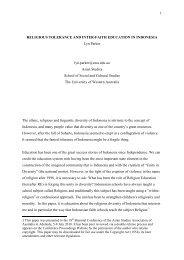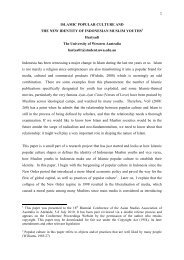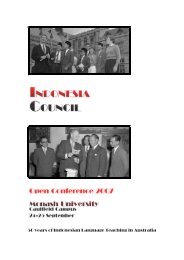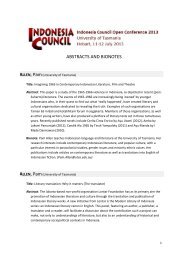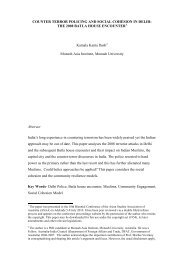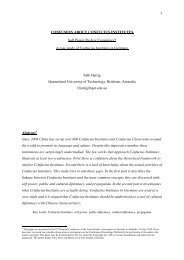Asian Currents - Asian Studies Association of Australia
Asian Currents - Asian Studies Association of Australia
Asian Currents - Asian Studies Association of Australia
Create successful ePaper yourself
Turn your PDF publications into a flip-book with our unique Google optimized e-Paper software.
<strong>Asian</strong> <strong>Currents</strong><br />
The <strong>Asian</strong> <strong>Studies</strong> <strong>Association</strong> <strong>of</strong> <strong>Australia</strong><br />
Maximising <strong>Australia</strong>’s <strong>Asian</strong> Knowledge<br />
July 2011 ISSN 1449–4418<br />
Pheua Thai’s election landslide<br />
delivers a delicate mandate<br />
Maintaining stability in the face <strong>of</strong> dedicated conservative enemies will be a challenge<br />
for Thailand’s new Pheua Thai government, writes MARC ASKEW.<br />
W<br />
ith the exiled former prime<br />
minister Thaksin Shinawatra‘s<br />
younger sister Yingluck as its<br />
titular leader, Thailand‘s Pheua Thai (For<br />
Thais) Party gained a spectacular victory<br />
in the country‘s national election on 3 July.<br />
The following day, the Pheua Thai Party<br />
leadership and key smaller parties<br />
brokered a new coalition government-inwaiting<br />
(including the former Democrat<br />
government ally, the Chart Thai Phatthana<br />
Party), which boosted Pheua Thai‘s<br />
absolute majority <strong>of</strong> 265 seats to a<br />
governing majority <strong>of</strong> 299 in the 500-seat<br />
lower house.<br />
The return <strong>of</strong> Thaksin‘s party to power<br />
once again, after being toppled twice by<br />
extraparliamentary forces and court action<br />
(in 2006 and 2008), marks an interesting<br />
phase in Thailand‘s volatile political<br />
history. It remains to be seen how<br />
Yingluck, a neophyte in politics, will<br />
perform as national leader, and how the<br />
new government will fund its raft <strong>of</strong><br />
populist policy commitments while keeping<br />
the economy stable.<br />
Despite the new government‘s massive<br />
electoral mandate, which has helped to<br />
keep the army quiescent, maintaining<br />
stability will be a challenge in the face <strong>of</strong><br />
dedicated conservative political enemies<br />
like the Democrat Party and the People‘s<br />
Alliance for Democracy.<br />
Following the <strong>of</strong>ficial dissolution <strong>of</strong><br />
parliament on 10 May, which marked the<br />
beginning <strong>of</strong> a 40-day campaign period,<br />
most analysts accepted the probability that<br />
the Pheua Thai Party would gain the<br />
highest number <strong>of</strong> seats in the contest<br />
against the incumbent Democrat-led<br />
coalition government under Abhisit<br />
Vejjajiva. But few expected the party to<br />
gain the decisive electoral majority that it<br />
eventually achieved.<br />
The party‘s<br />
crushing electoral<br />
triumph had much<br />
to do with its (and<br />
Thaksin‘s) choice <strong>of</strong><br />
Yingluck, the exiled<br />
Thaksin<br />
Shinawatra‘s<br />
Yingluck's televised victory younger sister, as<br />
speech.<br />
party leader, six<br />
days after the parliament‘s dissolution.<br />
From this time on, virtually all major<br />
political polls placed Pheua Thai in the<br />
lead. Acknowledgement <strong>of</strong> this trend led<br />
the Democrats, in the final week, to shift<br />
away from policy advocacy to a negative<br />
campaign against Thaksin as a bogeyman<br />
endangering the nation. Continued page 2 >><br />
In this issue<br />
Mekong mainstream dams: a revival 5<br />
Indonesia’s media moguls: managers<br />
or manipulators: 9<br />
Tagore: travels and translations 12<br />
‘Red love’—an intimate history <strong>of</strong> the making<br />
<strong>of</strong> North Korea 15<br />
Faltering resolve: the early release <strong>of</strong> Japan’s<br />
‘ordinary war criminals 17<br />
Confucius institutes in Germany and the limits<br />
<strong>of</strong> debate 21<br />
Reggae strikes chord with Indonesia’s<br />
‘disillusioned’ youth 24<br />
19th biennial ASAA conference 27<br />
Books on Asia 28<br />
<strong>Asian</strong> <strong>Currents</strong> July 2011 1
Thai election landslide<br />
<br />
<strong>Asian</strong> <strong>Currents</strong> July 2011 2
Thai election landslide<br />
><br />
<strong>Asian</strong> <strong>Currents</strong> July 2011 3
Thai election landslide<br />
Mekong mainstream dams: a revival<br />
PHILIP HIRSCH discusses the resource geopolitics around a dam proposed for the<br />
Mekong mainstream.<br />
O<br />
n 19 April 2011, the Joint<br />
Committee <strong>of</strong> the Mekong River<br />
Commission (MRC) met to decide<br />
the outcome <strong>of</strong> a six-month consultation<br />
on the proposal by one <strong>of</strong> the MRC<br />
member states, Lao PDR, to build a dam<br />
on the main stem <strong>of</strong> the Mekong<br />
(henceforth referred to as ‗the<br />
mainstream‘) at Xayaburi. The only<br />
agreement the permanent secretary-level<br />
representatives from Cambodia, Lao PDR,<br />
Thailand and Vietnam could reach was to<br />
elevate the decision to the Mekong<br />
Council, or ministerial level, for<br />
consideration at its annual meeting in<br />
October.<br />
early 1970s. In 1975, Cambodia withdrew<br />
from the committee, which then ticked<br />
along under interim arrangements with just<br />
three members (Lao PDR, Thailand and<br />
the newly unified Vietnam). While the<br />
Interim Mekong Committee managed to<br />
provide a slightly revised plan in 1987,<br />
which lowered the size <strong>of</strong> some <strong>of</strong> the<br />
planned structures, little happened on the<br />
ground.<br />
This seemingly inconsequential agreement<br />
to disagree was, in fact, one <strong>of</strong> the more<br />
significant recent events in regional<br />
geopolitics in the realm <strong>of</strong> transboundary<br />
natural resource development and<br />
management in Southeast Asia. To<br />
appreciate its significance, we need to<br />
look at the chequered and convoluted<br />
history <strong>of</strong> proposals for dams on the<br />
mainstream over the past half century.<br />
The Mekong Committee was established<br />
in 1957 under the auspices <strong>of</strong> the<br />
Economic Commission for Asia and the<br />
Far East (ECAFE) and under United<br />
States funding and tutelage, with the overriding<br />
agenda <strong>of</strong> planning a cascade <strong>of</strong><br />
dams on the Mekong. The mainstream<br />
was the focus <strong>of</strong> the committee‘s<br />
investigations, and by 1970 an indicative<br />
plan had proposed seven major structures<br />
that would have flooded areas currently<br />
occupied by more than one million people.<br />
If realised, these dams would have turned<br />
the lower 2000 kilometres <strong>of</strong> the Mekong<br />
River into a series <strong>of</strong> stepped lakes and<br />
flooded a significant part <strong>of</strong> the lower<br />
Mekong valley.<br />
The Cold War was the overriding context<br />
for the committee‘s existence and its work.<br />
The hotter war in Indochina prevented any<br />
<strong>of</strong> the mainstream plans from being<br />
implemented, although tributary dams<br />
were built in northeastern Thailand and at<br />
Nam Ngum in Laos during the 1960s and<br />
By the time the cooperative transboundary<br />
river basin institution was revitalised as the<br />
MRC under the 1995 Agreement on the<br />
Cooperation for the Sustainable<br />
Development <strong>of</strong> the Mekong River Basin,<br />
concerns over the environmental and<br />
social impacts <strong>of</strong> large dams had captured<br />
worldwide attention. Thailand‘s<br />
environmental movement had grown to the<br />
point <strong>of</strong> successfully challenging, and in<br />
1988 cancelling a major dam proposed for<br />
western Thailand. It followed this us by<br />
instituting a logging ban in 1989. Revival<br />
<strong>of</strong> plans for mainstream dams, even in a<br />
significantly toned down scheme <strong>of</strong> socalled<br />
‗run-<strong>of</strong>-river‘ projects, 1 proved highly<br />
controversial. At the same time, Laos and<br />
Vietnam had identified many sites for<br />
tributary dams, some <strong>of</strong> which were<br />
subject to criticism by environmental<br />
groups and other NGOs, and it seemed<br />
that the mainstream dam agenda had<br />
receded or even Continued page 6>><br />
<strong>Asian</strong> <strong>Currents</strong> July 2011 5
Mekong mainstream dams<br />
<br />
<strong>Asian</strong> <strong>Currents</strong> July 2011 6
Mekong mainstream dams<br />
><br />
<strong>Asian</strong> <strong>Currents</strong> July 2011 7
Mekong mainstream dams<br />
Indonesia’s media<br />
moguls: managers<br />
or manipulators<br />
The ownership <strong>of</strong> newspapers by<br />
politicians and businessmen in<br />
Indonesia leads to self-censorship by<br />
journalists who write for these<br />
publications, writes ROSS TAPSELL.<br />
I<br />
ndonesian journalists have a long<br />
history <strong>of</strong> enduring pressures in their<br />
pr<strong>of</strong>essional practice. During the New<br />
Order, the Indonesian Government and<br />
military controlled the ownership <strong>of</strong><br />
newspapers through press permits and<br />
strict laws enforced by the Ministry <strong>of</strong><br />
Information. Journalists and editors were<br />
forced to self-censor, and could not openly<br />
discuss topics regarded by authorities as<br />
‗taboo‘.<br />
In particular, topics such as the First<br />
Family‘s business interests, or military<br />
violence in the outer regions <strong>of</strong> the<br />
archipelago were not to be discussed<br />
openly in the press. With the fall <strong>of</strong> the<br />
New Order and closure <strong>of</strong> the Ministry <strong>of</strong><br />
Information, the processes to implement<br />
press freedom began, and initially over<br />
800 publications arose as a result.<br />
Today, Indonesia has a more vibrant and<br />
freer press through a range <strong>of</strong> mediums, in<br />
which considerable discussion and debate<br />
occurs on most topics. Journalists who<br />
operate in Indonesia today are certainly<br />
freer from government and military<br />
controls than were their predecessors, and<br />
owning a newspaper today does not mean<br />
adhering to draconian instructions from<br />
authorities.<br />
Yet despite 10 years <strong>of</strong> various democratic<br />
reforms, Indonesia still rates poorly in<br />
independent surveys <strong>of</strong> press freedom.<br />
Reporters Without Borders ranked<br />
Indonesia 117 out <strong>of</strong> 178 countries in their<br />
World Press Freedom Index for 2010.<br />
Columbia University-based Freedom<br />
House Institute categorises press freedom<br />
in Indonesia as only ‗partly free‘. While<br />
these surveys take into account a large<br />
number <strong>of</strong> factors, one concern for press<br />
freedom activists in Indonesia is that<br />
journalists continue to self-censor as they<br />
report on their owner‘s business or political<br />
interests.<br />
Indonesia‘s print media market continues<br />
to be dominated by daily newspapers<br />
Kompas and Jawa Pos, and the weekly<br />
newsmagazine, Tempo. However, since<br />
2006 there has been an increase in<br />
newspapers that are owned by prominent<br />
businessmen and politicians.<br />
This situation led Megawati Sukarnoputri,<br />
leader <strong>of</strong> the Democratic Party <strong>of</strong> Struggle<br />
[PDIP], to lament that her party, unlike<br />
others, did not have a major media<br />
publication through which to promote her<br />
views. She may have been alluding to<br />
some <strong>of</strong> the newspapers described below.<br />
In 2006,<br />
Indonesian<br />
President Susilo<br />
Bambang<br />
Yudhoyono<br />
[SBY]<br />
established<br />
Jurnal Nasional,<br />
a daily Indonesian-language broadsheet<br />
published in Jakarta. He appointed his<br />
spokesperson and now Minister for Sport,<br />
Andy Mallarengang, as one <strong>of</strong> the paper‘s<br />
administrators, and Ramadhan Pohan as<br />
the paper‘s first chief editor. Pohan<br />
stressed that SBY established the<br />
newspaper because ‗there should be a<br />
paper that did more than just report bad<br />
news – but good news as well‘. Sceptics<br />
who saw Jurnal Nasional as ‗SBY‘s party<br />
newspaper‘ were further vindicated when<br />
Pohan was appointed a member <strong>of</strong><br />
parliament in SBY‘s 2008 cabinet.<br />
Aburizal Bakrie is currently chief <strong>of</strong> the<br />
political party Golkar and is one <strong>of</strong> the<br />
richest and most powerful men in<br />
Indonesia. Bakrie-controlled companies<br />
cover the breadth <strong>of</strong> Indonesia's economy.<br />
They include mining, oil and gas, palm oil,<br />
property, telecommunications and finance.<br />
In 2008 Bakrie purchased the ailing<br />
newspaper, the Surabaya Post. This<br />
added to his portfolio <strong>of</strong> media businesses,<br />
which include stakes in television stations<br />
ANTV, TVONE, and ArekTV (Surabaya)<br />
and the online newswire service<br />
Vivanews! Bakrie‘s purchase <strong>of</strong> the<br />
Surabaya Post was particularly<br />
controversial because the paper had<br />
previously criticised his company, Lapindo<br />
Brantas, for its involvement Continued page 10>><br />
<strong>Asian</strong> <strong>Currents</strong> July 2011 9
Indonesia’s<br />
media moguls<br />
><br />
<strong>Asian</strong> <strong>Currents</strong> July 2011 10
Indonesia’s<br />
media moguls<br />
Tagore: travels<br />
and translations<br />
PETER FRIEDLANDER reflects on the<br />
genius <strong>of</strong> Rabindranath Tagore, whose<br />
150th birth anniversary is being<br />
celebrated around the world this year.<br />
T<br />
here is a lot <strong>of</strong> talk nowadays about<br />
India as an emerging superpower on<br />
the global scene and how it‘s only<br />
now that India is engaging with the wider<br />
world. But telling the story that way<br />
overlooks the history <strong>of</strong> continuous Indian<br />
engagements with the world. It forgets the<br />
countless Indian monks and Pandits who<br />
carried the teachings <strong>of</strong> the Buddha<br />
throughout Asia for centuries. It leaves out<br />
the story <strong>of</strong> Dean Mohammed, the first<br />
Indian to write a biography in English<br />
about his life in Ireland and regency<br />
England. It forgets the hundreds <strong>of</strong><br />
thousands <strong>of</strong> Indians who ventured out in<br />
search <strong>of</strong> work into colonies in South<br />
America, the Caribbean and the Pacific in<br />
the 19th century.<br />
Nor does telling a story <strong>of</strong> India only now<br />
emerging onto the world stage do justice<br />
to the lives <strong>of</strong> the Sindhi merchantile<br />
settlers in Meiji Japan, or 19th century<br />
Sikh traders in outback <strong>Australia</strong>.<br />
Moreover, it forgets the role <strong>of</strong> one the<br />
most prominent figures in 20th century<br />
Indian history, Rabindranath Tagore<br />
(1861–1941), whose 150th birth<br />
anniversary is being celebrated around the<br />
world this year.<br />
Tagore was the first Indian, and indeed<br />
<strong>Asian</strong>, to win the Nobel Prize for literature,<br />
in 1913: the outcome not only <strong>of</strong> Tagore‘s<br />
genius but also his engagement with the<br />
world and his travels outside <strong>of</strong> India. Nor<br />
were his travels limited to Western<br />
Europe, for he visited over 22 countries,<br />
from Russia to the United States, and<br />
throughout Asia and Southeast Asia.<br />
Unfortunately for us, he never visited<br />
<strong>Australia</strong>.<br />
The accounts <strong>of</strong> his travels also give a<br />
vivid insight into not only how Tagore<br />
sought to understand India‘s relation to the<br />
wider world, but also to how India was<br />
seen by different cultures during his<br />
lifetime.<br />
His first experience<br />
<strong>of</strong> foreign travel was<br />
in 1878–80, when he<br />
went to England to<br />
study at the age <strong>of</strong><br />
only 17. However,<br />
his most significant<br />
interaction with life in<br />
England came during<br />
his visit there during<br />
1912. At this time he became, for many<br />
who came into contact with him in London,<br />
the personification <strong>of</strong> India—an<br />
embodiment <strong>of</strong> what was seen as India‘s<br />
mystical heart.<br />
His host in London, the painter William<br />
Rothenstein, went so far as to write to<br />
George Bernard Shaw: ‗I want you to meet<br />
Rabindra Nath Tagore, for you have not<br />
met many saints in your life‘ 1 Perceptions<br />
<strong>of</strong> Tagore as an Indian mystic sage can<br />
also be seen in the views <strong>of</strong> his English<br />
collaborator Evelyn Underhill with whom<br />
he worked on translations <strong>of</strong> the Indian<br />
poet-saint Kabir‘s verses. These, I have<br />
recently argued, were successful largely<br />
because <strong>of</strong> the way that Underhill<br />
conflated in them Tagore, Kabir and her<br />
own Christian mysticism. 2<br />
This points to a central paradox in India‘s<br />
relationship with the wider world, the<br />
tendency for each side to see the other<br />
through stereotypes. However, his English<br />
host‘s focus on Tagore as mystic India<br />
personified seems to be very one<br />
dimensional compared to Tagore‘s more<br />
nuanced approach to the British<br />
establishment, the movements <strong>of</strong> those<br />
interested in spirituality in the UK, and,<br />
indeed, the Irish community‘s struggle for<br />
independence.<br />
The issue was, in a sense, how to<br />
translate not just from one language to<br />
another, but from one culture to another.<br />
Tagore‘s approach at this point was to<br />
collaborate with the Irish Poet Yeats, and<br />
to create a form <strong>of</strong> performance for his<br />
poetry at which ‗Yeats would read some <strong>of</strong><br />
the translations from Gitanjali while Tagore<br />
would sing the songs in the original‘. 3<br />
The success <strong>of</strong> this form <strong>of</strong> presentation<br />
was clear; the English versions <strong>of</strong> his<br />
verses so inspired his audiences that he<br />
ended up winning the Nobel Prize.<br />
However, it is interesting to Continued page 13>><br />
<strong>Asian</strong> <strong>Currents</strong> July 2011 12
Tagore: travels<br />
and translations<br />
><br />
<strong>Asian</strong> <strong>Currents</strong> July 2011 13
Tagore: travels<br />
and translations<br />
‘Red love’—an<br />
intimate history<br />
<strong>of</strong> the making <strong>of</strong><br />
North Korea<br />
RUTH BARRACLOUGH explores the<br />
life <strong>of</strong> a woman who, in her lifetime,<br />
became Korea’s greatest and most<br />
notorious communist feminist.<br />
A<br />
t a time when North Korea appears<br />
as inscrutable as ever, and the inner<br />
lives <strong>of</strong> its citizens elusive, my<br />
research for a new book Red love and<br />
betrayal in the making <strong>of</strong> North Korea<br />
embarks on an intimate history <strong>of</strong> the lives<br />
<strong>of</strong> key communist figures in Korea. In<br />
particular, I am interested in using history<br />
and biography to examine the lives <strong>of</strong> the<br />
first communist women in Korea, and their<br />
role in the making <strong>of</strong> the Democratic<br />
Peoples Republic <strong>of</strong> Korea (DPRK).<br />
North Korea is today known as a pariah<br />
state, impenetrable to outside observers.<br />
But part <strong>of</strong> the reason for this is that we<br />
focus so much on the North Korean<br />
regime, and neglect to examine the<br />
everyday life <strong>of</strong> its people. Harnessing<br />
archival sources from the period when<br />
Korea was a colony <strong>of</strong> Japan (1910–45),<br />
and the early liberation years (1945–50),<br />
this project examines the intimate lives <strong>of</strong><br />
those who created Korea‘s communist<br />
state.<br />
Most importantly, this project, also, is a<br />
history that attempts to be relevant to the<br />
present. In researching the lives <strong>of</strong> early<br />
communist women, and the legacy they<br />
created in both the north and the south <strong>of</strong><br />
Korea, we become reacquainted with the<br />
terrible contingency <strong>of</strong> division. Looking<br />
back and looking ahead to the future <strong>of</strong><br />
North Korea, this project restores<br />
individuals‘ own acts <strong>of</strong> faith, betrayal and<br />
complicity that are part <strong>of</strong> the foundational<br />
history <strong>of</strong> the creation <strong>of</strong> North Korea.<br />
Despite what the censorship regime in<br />
North Korea might have us believe, people<br />
in the early socialist movement in the<br />
1920s, 30s and 40s led very interesting<br />
and varied lives. Given Korean radicals‘<br />
propensity for international travel<br />
(otherwise known as exile), and their<br />
fondness for the written word, sources on<br />
the early life <strong>of</strong> key figures in the<br />
communist movement are plentiful.<br />
In investigating what happened to leading<br />
communist women after 1945 we find that<br />
some succeeded in North Korea while<br />
others were purged, or bailed altogether<br />
from the communist experiment. Of the<br />
four women whose lives I explore in this<br />
book, only one had a successful political<br />
career in the DPRK. She is Hô Jông-suk<br />
(1902–91), who would in her lifetime<br />
become Korea‘s greatest and most<br />
notorious communist feminist.<br />
Hô Jông-suk—as famous for<br />
her promiscuity as for her<br />
politics.<br />
Hô Jông-suk‘s story<br />
is a tale <strong>of</strong> how one<br />
becomes complicit<br />
with a murdering<br />
state. And her<br />
intimate life is<br />
essential to<br />
understanding her<br />
for she was as<br />
famous for her<br />
promiscuity as for<br />
her politics. Her love<br />
affairs and elopements that thrilled and<br />
horrified colonial Korea in the 1920s and<br />
30s culminated in 1957–8 in the<br />
denunciation <strong>of</strong> her former husband,<br />
Choe Chang-k, an indictment that<br />
completed his purge.<br />
To some, Hô Jông-suk displayed<br />
throughout her life a consistent<br />
ruthlessness. In all <strong>of</strong> her intimate<br />
relationships, she always managed to<br />
shuck <strong>of</strong>f an old allegiance in time to<br />
embrace the winning faction/partner. To<br />
these observers she is the very model <strong>of</strong> a<br />
treacherous and self-serving flunkey who<br />
thrives in dictatorships. To feminists, she<br />
is a powerful and troubling figure. Because<br />
she left a literary trail—she wrote, gave<br />
interviews, and inspired fictional<br />
accounts—she is available to historians in<br />
a way that others <strong>of</strong> her contemporaries<br />
are not. She lived through colonial Korea‘s<br />
garrulous 1920s and 30s and her age, the<br />
very longevity <strong>of</strong> her career, allows us to<br />
read, through her life story, an intimate<br />
tale <strong>of</strong> the making <strong>of</strong> North Korea.<br />
Korea became a colony <strong>of</strong> Japan in 1910<br />
and seven years later the Bolsheviks in<br />
neighbouring Russia Continued page 16>><br />
<strong>Asian</strong> <strong>Currents</strong> July 2011 15
‘Red love’: an<br />
intimate history<br />
><br />
<strong>Asian</strong> <strong>Currents</strong> July 2011 16
‘Red love’: an<br />
intimate history<br />
Faltering resolve: the early release<br />
<strong>of</strong> Japan’s ‘ordinary’ war criminals<br />
The reasons for the early release <strong>of</strong><br />
many ‘ordinary’ Japanese war<br />
criminals in the 1950s were<br />
complex and <strong>of</strong>ten pragmatic,<br />
writes BEATRICE TREFALT.<br />
C<br />
lass B and C 1 war crimes trials in<br />
Asia after World War II prosecuted<br />
'ordinary' Japanese war criminals,<br />
rather than the high-pr<strong>of</strong>ile leaders brought<br />
before the International Military Tribunal<br />
for the Far East, better known as the<br />
Tokyo War Crimes Trial. 2<br />
'Lesser' war crimes trials were conducted<br />
by seven Allied nations in about 50<br />
courtrooms around Asia and the Pacific<br />
between 1946 and 1951. While these trials<br />
have received some scholarly attention, 3<br />
little is known about their aftermath, and<br />
the processes by which convicted<br />
Japanese war criminals served out their<br />
sentences, either in prisons throughout the<br />
Southeast <strong>Asian</strong> region or in Sugamo<br />
Prison in Tokyo.<br />
The imprisonment, repatriation and<br />
eventual release <strong>of</strong> war criminals was an<br />
issue that preoccupied governments in<br />
Japan and the former wartime Allies in<br />
several emerging independent countries <strong>of</strong><br />
Southeast Asia between the Japanese<br />
surrender in 1945 and the release <strong>of</strong> the<br />
last war criminals were released from<br />
Sugamo in 1958.<br />
This period was a formative one in the<br />
international relations <strong>of</strong> the region: Japan<br />
was gradually rehabilitated, many <strong>of</strong> the<br />
countries previously occupied by Japan<br />
reached independence from their<br />
European overlords as well as the<br />
Japanese, and the Cold War shaped new<br />
sets <strong>of</strong> alliances in the region.<br />
The treatment <strong>of</strong> Japanese war criminals,<br />
once they had been convicted, varied<br />
dramatically according to whether the<br />
prosecuting country was the United<br />
States, <strong>Australia</strong>, Great Britain, the<br />
Netherlands, the Chinese Republic,<br />
France or the Philippines. 4<br />
In the wake <strong>of</strong> the war, class B and C war<br />
crimes trials were convened either by one<br />
<strong>of</strong> the wartime Allies—<strong>of</strong>ten also the<br />
colonial master <strong>of</strong> the territory in which the<br />
war crimes had occurred—or, in the case<br />
<strong>of</strong> the Philippines, by a newly independent<br />
nation. Of 5700 defendants, 984 were<br />
sentenced to death, 475 to life<br />
imprisonment and 2944 to various prison<br />
terms.<br />
The last trials were conducted by <strong>Australia</strong><br />
on Manus Island in 1951. <strong>Australia</strong> and the<br />
Philippines were also the last, in July<br />
1953, to repatriate war criminals, many <strong>of</strong><br />
whom continued their sentences in<br />
Sugamo prison in Tokyo. By 1958, all war<br />
criminals convicted under the BC trial<br />
system had been released from Sugamo.<br />
In Japan war criminals, their<br />
families and supporters applied<br />
considerable political pressure on<br />
the Japanese Government to work<br />
for their release.<br />
The release <strong>of</strong> war criminals was not<br />
something that the Japanese government<br />
could effect unilaterally. Despite the<br />
steady dilution <strong>of</strong> the Allied Occupation‘s<br />
early determination to punish Japan, the<br />
country displayed gradual economic and<br />
political rehabilitation from 1947 onwards,<br />
and returned to sovereignty on 28 April<br />
1952.<br />
As Sandra Wilson has shown, in Japan<br />
war criminals, their families and supporters<br />
applied considerable political pressure on<br />
the Japanese Government to work for their<br />
release, 5 but the government was limited<br />
to making representations on behalf <strong>of</strong> the<br />
prisoner to the nation in which, or on<br />
whose behalf, he was jailed. Repatriation<br />
and release <strong>of</strong> war criminals marked, in<br />
many cases, one <strong>of</strong> the first major areas <strong>of</strong><br />
negotiation in new postwar relationships<br />
between Japan and the countries <strong>of</strong> the<br />
region, and, and between Japan and the<br />
imperialist powers that had formerly ruled<br />
in Asia. Continued page 19>><br />
<strong>Asian</strong> <strong>Currents</strong> July 2011 18
Early release<br />
<strong>of</strong> Japan’s<br />
war criminals<br />
Early release<br />
<strong>of</strong> Japan’s<br />
war criminals<br />
Confucius<br />
institutes in<br />
Germany<br />
and the limits <strong>of</strong><br />
debate<br />
Confucius institutes in Germany are<br />
dealing with topical Chinese issues—<br />
but some subjects are <strong>of</strong>f limits. FALK<br />
HARTIG reports.<br />
S<br />
ince 2004 China has established<br />
more than 700 Confucius Institutes<br />
and Confucius classrooms around<br />
the world to promote its language and<br />
culture, and thereby shape its image.<br />
While Chinese <strong>of</strong>ficials identify the<br />
institutes as an important tool <strong>of</strong> China‘s<br />
international exchange and image-shaping<br />
program, western academic interest in<br />
them remains surprisingly small.<br />
Besides the theoretical confusion about<br />
what Confucius institutes are (a<br />
propaganda tool, an instrument <strong>of</strong> s<strong>of</strong>t<br />
power, <strong>of</strong> public diplomacy or cultural<br />
diplomacy), the lack <strong>of</strong> knowledge about<br />
their activities is striking.<br />
By providing some insights into the<br />
operation <strong>of</strong> Confucius institutes in<br />
Germany, I want to shed more light on<br />
their activities around the world. This<br />
analysis is based on interviews with<br />
managers <strong>of</strong> German Confucius Institutes<br />
and an evaluation <strong>of</strong> the institutes‘<br />
programs and annual working reports.<br />
The first Confucius institute in Germany<br />
was established in 2006, at the Free<br />
University <strong>of</strong> Berlin. Currently there are 11<br />
Confucius institutes and one Confucius<br />
classroom in Germany. All have been<br />
organised through cooperation between<br />
Chinese and German partner institutions.<br />
Nearly all <strong>of</strong> the institutions are hosted in<br />
universities with a department <strong>of</strong> Sinology<br />
or China studies, and which have worked<br />
closely with Chinese universities for a long<br />
time. This cooperation has usually been<br />
the basis for the establishment <strong>of</strong> a<br />
Confucius institute.<br />
Another organisational component worth<br />
noting is that Confucius institutes in<br />
Germany are formally German-registered<br />
associations. This might seem rather<br />
unimportant, but is significant when you<br />
consider that the Chinese Government<br />
restricts the establishment <strong>of</strong> foreign<br />
cultural institutions in China. There are still<br />
only a few foreign cultural institutions in<br />
Beijing; Germany‘s Goethe Institute,<br />
present since 1988, is the oldest, followed<br />
by the French, in 2004 and the Spanish, in<br />
2005.<br />
China‘s <strong>of</strong>ficial policy<br />
is ‗one country, one<br />
cultural institute‘. In<br />
the case <strong>of</strong><br />
Confucius institutes,<br />
however, it avoids<br />
this restriction<br />
because in Germany<br />
the institutes are<br />
formally registered associations, rather<br />
than Chinese institutions. This means<br />
China can easily establish more than one<br />
cultural institute, without impinging on<br />
<strong>of</strong>ficial cultural treaties and agreements<br />
that concern the so-called Chinese Culture<br />
Centre in Berlin.<br />
Chinese culture centres—there are only<br />
two others in Europe, in Malta and Paris—<br />
also provide language and culture courses<br />
and are similar to Confucius institutes in<br />
the type <strong>of</strong> content they provide. However,<br />
the centres are organised, operated and<br />
financed solely by the Chinese Ministry <strong>of</strong><br />
Culture, without an international partner.<br />
With Confucius Institutes, the cooperative<br />
model for their establishment also applies<br />
to their funding. The average annual<br />
subsidy paid by Hanban ( the Chinese<br />
National Office for Teaching Chinese as a<br />
Foreign Language) to each German<br />
Confucius Institute is about US$100 000,<br />
with the German partner contributing<br />
about the same amount through facilities<br />
and, sometimes, payment for local staff.<br />
Institutes can apply for further funding<br />
from Hanban for specific projects. When<br />
the first German institutes were<br />
established in 2006–07, Hanban‘s policy<br />
<strong>of</strong> signing contracts for only three years<br />
led to some insecurity about financial<br />
support at the end <strong>of</strong> the contract period.<br />
This policy now seems to have been<br />
relaxed, and the managing Continued page 22<br />
<strong>Asian</strong> <strong>Currents</strong> July 2011 21
Confucius institutes<br />
in Germany<br />
><br />
<strong>Asian</strong> <strong>Currents</strong> July 2011 22
Confucius institutes<br />
in Germany<br />
Reggae strikes a chord with<br />
Indonesia’s ‘disillusioned’ youth<br />
Indonesians are borrowing the music <strong>of</strong> reggae to shed light on the modern Indonesian<br />
condition, writes LISA COLQUHOUN.<br />
F<br />
rom Aceh to Ambon, dreadlocked<br />
Indonesian musicians are laying claim<br />
to reggae. They are hybridising the<br />
Jamaican musical genre, fertilising the<br />
imported musical code with local<br />
particularities and definitions and instilling it<br />
with characteristics and meanings unique to<br />
Indonesia and its various regional cultures.<br />
By gesturing to Jamaica as a source <strong>of</strong><br />
cultural influence—borrowing not only the<br />
music <strong>of</strong> reggae but also its associated<br />
Rastafarian discourses—Indonesian reggae<br />
musicians are demonstrating that the<br />
increasing interconnectivity <strong>of</strong> cultures that<br />
characterises globalisation, rather than<br />
fulfilling prophecies <strong>of</strong> standardised Western<br />
Western blandness is, instead, equipping<br />
local actors worldwide with a broad<br />
repertoire <strong>of</strong> cultural forms ripe for<br />
appropriation and reinterpretation. This is<br />
giving rise to new fashions, patterns and<br />
hybrids.<br />
Whatever path reggae travelled along on its<br />
journey to Indonesian shores, by all<br />
accounts it was initially most popular in the<br />
tourist resorts <strong>of</strong> Bali and Lombok,<br />
particularly in the late 1980s and 1990s. It<br />
was here, within the borders <strong>of</strong> Indonesia‘s<br />
tourism industry, that reggae was<br />
disconnected from its roots as a purveyor <strong>of</strong><br />
Rastafarian resistance to colonial<br />
exploitation and, instead was performed as a<br />
commodity <strong>of</strong> the tourism industry.<br />
Local musicians who visited the bars that<br />
had become known for live reggae, including<br />
Bruna Bar on Bali‘s Kuta Beach and Pondok<br />
Senggigi on Lombok‘s west coast, were<br />
gripped by reggae‘s gentle rhythm and its<br />
invitation to sway. Despite having no<br />
understanding <strong>of</strong> what reggae was really all<br />
about, and unable to comprehend the<br />
Jamaican-accented English <strong>of</strong> the lyrics,<br />
many turned to the genre as a ticket to a<br />
regular hotel gig, playing covers <strong>of</strong> Bob<br />
Marley classics for tipsy tourists on holiday<br />
in paradise.<br />
When the 1997–98 <strong>Asian</strong> financial crisis,<br />
followed by the 2002 terrorist bombings in<br />
Kuta, devastated the tourism industries in<br />
both Bali and Lombok, reggae was robbed <strong>of</strong><br />
its primary audience in Indonesia. The main<br />
venues for live reggae music closed down<br />
and, for a while, the reggae musicians in Bali<br />
and Lombok were out <strong>of</strong> work. Unemployed,<br />
and some fearing for their lives, reggae<br />
musicians fled to Jakarta and other<br />
Indonesian cities, leaving the fate <strong>of</strong> reggae<br />
music in Indonesia doubtful.<br />
However, the migration <strong>of</strong> reggae music to<br />
beyond the borders <strong>of</strong> Indonesia‘s tourism<br />
industry spawned a new enthusiasm for the<br />
genre. Reggae found an eager audience in<br />
Indonesia‘s urban youth who, according to<br />
Javanese reggae legend, Tony Q, were<br />
growing increasingly ‗bored with the<br />
American style pop on MTV that [had] ruled<br />
the music industry for the past decade‘.<br />
Tony Q Rastafara performing at<br />
BB’s in Jakarta.<br />
In Jakarta,<br />
Bandung,<br />
Yogyakarta, Medan<br />
and Makassar, for<br />
example, a host <strong>of</strong><br />
new reggae bands<br />
were formed,<br />
including Tuff<br />
Gong, Souljah,<br />
Gangstarasta and Marapu. Tpenk, former<br />
frontman <strong>of</strong> Indonesia‘s most commercially<br />
successful reggae band, Steven and<br />
CoconuTTreez, and current frontman <strong>of</strong><br />
Steven Jam, proposed: ‗Even though reggae<br />
was popular in Bali in the 1990s, it wasn‘t<br />
until the 2000s that it became popular<br />
elsewhere and Indonesians really started to<br />
make reggae for Indonesians, not just sing<br />
Bob Marley and UB40 for tourists‘.<br />
While Tony Q, with his band Rastafara, was<br />
already experimenting with the localisation <strong>of</strong><br />
reggae music in the 1990s, it was not until<br />
the early-to mid-2000s, that other reggae<br />
musicians in the nation‘s cities began<br />
actively and increasingly fusing local musical<br />
and linguistic elements with reggae. The<br />
increased accessibility <strong>of</strong> the internet in the<br />
country‘s urban areas made it Continued page 25>><br />
<strong>Asian</strong> <strong>Currents</strong> July 2011 24
Reggae in Indonesia<br />
Reggae in Indonesia<br />
19th biennial ASAA conference<br />
<strong>Asian</strong> <strong>Studies</strong> in an <strong>Asian</strong> century<br />
P<br />
reparations have begun for the 19th<br />
Biennial Conference <strong>of</strong> the <strong>Asian</strong><br />
<strong>Studies</strong> <strong>Association</strong> <strong>of</strong> <strong>Australia</strong><br />
(ASAA), in Sydney in 2012.<br />
The theme <strong>of</strong> the conference will be<br />
‗Knowing Asia: <strong>Asian</strong> <strong>Studies</strong> in an <strong>Asian</strong><br />
Century‘. The conference will be hosted by<br />
the Institute for Culture and Society, the<br />
School <strong>of</strong> Humanities and<br />
Communications, and the Centre for Study<br />
<strong>of</strong> Contemporary Muslim Societies, at the<br />
Parramatta campus <strong>of</strong> the University <strong>of</strong><br />
Western, and will be held from<br />
11 to 14 July.<br />
As the 21st century marches on, what we<br />
call ‗<strong>Asian</strong> studies‘ is no longer an easily<br />
demarcated field. The area studies model<br />
<strong>of</strong> <strong>Asian</strong> <strong>Studies</strong>, with its focus on<br />
particular areas within Asia (China,<br />
Indonesia, Japan and so on) as bounded<br />
objects <strong>of</strong> Western knowledge, has come<br />
under sustained criticism. In the past few<br />
decades massive economic, political,<br />
social and cultural transformations have<br />
taken place in the region known as Asia.<br />
In the process, it has acquired an<br />
increasingly prominent place in the world.<br />
Whether or not this ‗rise <strong>of</strong> Asia‘ merits talk<br />
about a coming ‗<strong>Asian</strong> century‘, it is clear<br />
that the historical context for the study <strong>of</strong><br />
Asia has irrevocably changed.<br />
Four major considerations are at play<br />
here. First, increasing globalisation has led<br />
to growing interpenetration and<br />
interdependence between different parts<br />
<strong>of</strong> the world. This problematises prevailing<br />
boundaries, not least those between ‗Asia‘<br />
and ‗the West‘. Cross-border interactions<br />
and transnational connections across and<br />
beyond the region are now vital<br />
determinants <strong>of</strong> local and national<br />
conditions in all parts <strong>of</strong> Asia. As a<br />
consequence, now more than ever, such<br />
local and national situations cannot be<br />
meaningfully studied without consideration<br />
<strong>of</strong> the constitutive role <strong>of</strong> the broader<br />
regional and global context. At the same<br />
time, studies <strong>of</strong> global significance must<br />
increasingly include studies <strong>of</strong> what is<br />
occurring in Asia.<br />
Second, economic development<br />
throughout the region has given rise to the<br />
emergence <strong>of</strong> complex and vibrant new<br />
societies for which descriptors as<br />
‗traditional‘ or ‗postcolonial‘ are<br />
inadequate, and whose understanding can<br />
no longer be pursued through using<br />
Western modernity as a benchmark.<br />
These societies are becoming modern in<br />
their own ways, requiring new concepts<br />
and tools for analysis. Third, these recent<br />
transformations have led to a burgeoning<br />
interest in studying Asia among scholars<br />
who do not call themselves ‗<strong>Asian</strong>ists‘, for<br />
example in cultural and media studies,<br />
gender and sexuality studies, and human<br />
and urban geography.<br />
Thus, intellectual engagement with Asia<br />
has widened considerably beyond the<br />
area studies template and its disciplinary<br />
core <strong>of</strong> political science, history and<br />
languages. Fourth, and crucially, as<br />
modern <strong>Asian</strong> societies mature there are<br />
new generations <strong>of</strong> <strong>Asian</strong> scholars who<br />
conduct research and scholarship on and<br />
within their own societies, establishing<br />
their own, intraregional scholarly networks.<br />
For these scholars, Asia is not ‗other‘, as<br />
is still <strong>of</strong>ten the case for Western scholars.<br />
In short, as Asia becomes an increasingly<br />
prominent, complex and self-confident<br />
region in the world, the meanings and<br />
potentials <strong>of</strong> ‗knowing Asia‘ require<br />
fundamental rethinking at multiple levels.<br />
‗The conference will encourage reflection<br />
on the implications <strong>of</strong> these shifts on the<br />
field <strong>of</strong> <strong>Asian</strong> studies, both in <strong>Australia</strong> and<br />
internationally,‘ said co-convenors:<br />
Pr<strong>of</strong>essor Ien Ang, Pr<strong>of</strong>essor <strong>of</strong> Cultural<br />
<strong>Studies</strong> and the founding Director <strong>of</strong> the<br />
Centre <strong>of</strong> Cultural Research (CCR) at the<br />
University <strong>of</strong> Western Sydney (UWS), and<br />
Associate Pr<strong>of</strong>essor Judith Snodgrass,<br />
UWS Centre <strong>of</strong> Cultural Research.<br />
The website is currently under<br />
construction and will open soon with news<br />
<strong>of</strong> keynotes, panel themes, and events.<br />
There will be a link from the ASAA<br />
homepage.<br />
<strong>Asian</strong> <strong>Currents</strong> July 2011 27
Books on Asia<br />
National Library’s<br />
<strong>Asian</strong> treasures<br />
celebrated<br />
in book form<br />
By Sally Burdon<br />
Asia Bookroom<br />
I would hazard a guess that<br />
if a group <strong>of</strong> educated<br />
<strong>Australia</strong>ns were surveyed<br />
as to the ethnic origin <strong>of</strong> the oldest book in<br />
the National Library <strong>of</strong> <strong>Australia</strong> most<br />
would presume the work to be <strong>of</strong><br />
European origin. They would not guess<br />
that the oldest printed book in the NLA,<br />
published in 1162, is a Chinese volume<br />
from a very large set <strong>of</strong> Buddhist<br />
scriptures. Nor would they suspect how<br />
influential this work, published nearly 800<br />
years ago is, and not just in Buddhist<br />
circles.<br />
It was from these scriptures that Monkey,<br />
<strong>of</strong> fictional book and television series<br />
fame, had its origins. Such is the crosscultural<br />
reach <strong>of</strong> just this work, which is<br />
only one <strong>of</strong> the treasures described in<br />
<strong>Asian</strong> treasures: gems <strong>of</strong> the written word.<br />
<strong>Asian</strong> treasures: gems <strong>of</strong> the written word<br />
is the aptly titled new publication from the<br />
NLA. Engagingly written and beautifully<br />
illustrated, this introduction to the depth,<br />
diversity and beauty <strong>of</strong> the <strong>Asian</strong><br />
collections held at the library is an elegant<br />
and inspiring book. Written for the<br />
intelligent general reader, author Andrew<br />
Gosling assumes no prior knowledge <strong>of</strong><br />
the items described or <strong>of</strong> the history <strong>of</strong><br />
Asia. He discusses the treasures in their<br />
historical, literary and artistic context, while<br />
not oversimplifying their content. This is<br />
not an easy task but one he performs with<br />
aplomb.<br />
Choosing what<br />
to include in<br />
<strong>Asian</strong> treasures<br />
from the<br />
enormous and<br />
Map <strong>of</strong> Nagasaki.<br />
important <strong>Asian</strong><br />
collections that<br />
the NLA holds must have been a near<br />
impossible mission. Andrew Gosling, who<br />
spent 30 years on the NLA staff and who<br />
was Chief Librarian, <strong>Asian</strong> Collections for<br />
18 <strong>of</strong> those years, would have been<br />
cognisant <strong>of</strong> the daunting nature <strong>of</strong> this<br />
task, but thankfully he persevered and a<br />
fascinating and useful book has come out<br />
<strong>of</strong> it.<br />
Anyone who has had the good fortune to<br />
use these collections can attest to how<br />
truly wonderful they are. In fact, so<br />
important are the NLA‘s <strong>Asian</strong> holdings<br />
that frequently scholars from across the<br />
world travel to Canberra to work at the<br />
library because there is nowhere else<br />
worldwide with quite the NLA‘s scope.<br />
<strong>Asian</strong> treasures: gems<br />
<strong>of</strong> the written word is<br />
divided into seven parts<br />
and includes<br />
descriptions <strong>of</strong> stunning<br />
books, maps,<br />
manuscripts on paper<br />
and palm leaf, letters<br />
and scrolls. With<br />
origins ranging from Northeast Asia,<br />
through the writing traditions <strong>of</strong> the<br />
Indonesian islands, South Asia and the<br />
Middle East, this book serves as a window<br />
into the extraordinary cultural and historic<br />
depth <strong>of</strong> our neighbours.<br />
There are so many<br />
items <strong>of</strong> intellectual<br />
and artistic beauty<br />
described in this<br />
book that I am sure it<br />
will inspire many<br />
readers to want to<br />
view the physical<br />
objects. The<br />
popularity <strong>of</strong> the<br />
Old Javanese Ramayana.<br />
‗Treasures‘<br />
exhibitions at the NLA some years ago<br />
demonstrated the public‘s appetite for<br />
such celebrations.<br />
Wouldn't the 21st century—the <strong>Asian</strong><br />
century—be the perfect time for an ‗<strong>Asian</strong><br />
treasures‘ exhibition at the NLA<br />
In the meantime, I highly recommend this<br />
treasure <strong>of</strong> a book, both for personal<br />
libraries and as a wonderful present to<br />
give when travelling in Asia. Andrew<br />
Gosling is to be congratulated for this<br />
demonstration that <strong>Australia</strong> is very<br />
serious about our relationship with Asia.<br />
<strong>Asian</strong> <strong>Currents</strong> July 2011 28
Books on Asia<br />
New books from the ASAA series<br />
Southeast Asia Series<br />
The series seeks to publish cutting-edge<br />
research on all countries and peoples <strong>of</strong><br />
Southeast Asia.<br />
Women in Asia Series<br />
The Women's Caucus <strong>of</strong> the ASAA<br />
operates a publication series in<br />
conjunction with Routledge that focuses<br />
on promoting scholarship for women in<br />
Asia.<br />
The East Asia Series<br />
The series welcomes proposals on<br />
subjects principally concerned with any<br />
part <strong>of</strong> the East <strong>Asian</strong> region (China,<br />
Japan, North and South Korea and<br />
Taiwan).<br />
South Asia Series<br />
The series publishes outstanding research<br />
on the countries and peoples <strong>of</strong> South<br />
Asia across a wide range <strong>of</strong> disciplines.<br />
Job websites<br />
www.jobs.ac.uk advertises worldwide academic<br />
posts.<br />
http://reliefweb.int/ is a free service run by the<br />
United Nations to recruit for NGO jobs<br />
http://www.aboutus.org/DevelopmentEx.com<br />
has a paid subscription service providing<br />
access to jobs worldwide in the international<br />
development industry.<br />
https://h-net.org/jobs/home.php is a US-based<br />
site with a worldwide scope. Asia-related jobs<br />
(mostly academic) come up most weeks.<br />
http://www.aasianst.org/ is the website <strong>of</strong> the<br />
<strong>Association</strong> for <strong>Asian</strong> <strong>Studies</strong> (AAS). New job<br />
listings are posted on the first and third Monday<br />
<strong>of</strong> each month. You must be a current AAS<br />
member to view job listings.<br />
http://www.timeshighereducation.co.uk/jobs_ho<br />
me.asp is The Times Higher Education<br />
Supplement.<br />
http://www.comminit.com/global/spacesfrontpage<br />
is the site <strong>of</strong> The Communication<br />
Initiative Network.<br />
http://isanet.ccit.arizona.edu/employment.html<br />
is a free-to-access website run by the<br />
International <strong>Studies</strong> <strong>Association</strong>.<br />
Diary notes<br />
‘Japan Design Today 100’, 29 July–16<br />
September 2011, Sydney. An exhibition on<br />
the evolution <strong>of</strong> Japanese design on everyday<br />
products, at the Japan Foundation Gallery,<br />
Level 1, Chifley Plaza, Chifley Square, Sydney,<br />
Monday–Friday, 11am–4pm, Wednesday until<br />
8pm. www.jpf.org.au.<br />
TAASA <strong>Asian</strong> Arts Essay Prize, extension <strong>of</strong><br />
deadline. To celebrate its 20th Anniversary in<br />
2011, the <strong>Asian</strong> Arts Society <strong>of</strong> <strong>Australia</strong> is<br />
<strong>of</strong>fering a $2000 prize for the winning essay on<br />
an <strong>Asian</strong> arts topic. The final submission date<br />
is now 1 August 2011, with the award<br />
announcement on 31 October 2011. Inquiries<br />
to Dr Ann Proctor at a proctor@bigpong.net.au.<br />
The 2011 Herb Feith Memorial Lecture,<br />
Monash University Melbourne, 2 August<br />
2011, by HE Kirsty Sword Gusmão, 6 pm for<br />
6.30 pm–8 pm, RSVP Monday 25 July,<br />
2011,Eric Cheng, 03 9903 4616 or at<br />
eric.cheng@monash.edu.<br />
‘Living Histories’ 2011 interview series, the<br />
Japan Foundation <strong>of</strong> Sydney. Interviews<br />
include Sayuki, the <strong>Australia</strong>n-born geisha, and<br />
Testsu Kariya, Sydney-based author <strong>of</strong> the<br />
Oishinbow manga series. Attendance is free.<br />
Interviews will be held in the Multipurpose<br />
Room, the Japan Foundation, Shop 23, level 1,<br />
Chifley Plaza, 2 Chifley Square, Sydney, on the<br />
following dates: 3 August: Christina Wilcox<br />
and Peter Rushforth; 17 August, Sayuki; 31<br />
August, Tetsu Kariya; 7 September, Dr<br />
Christine de Matos and Kathy Wray; 14<br />
September, Walter Hamilton and Alan Stokes;<br />
28 September, Father Paul Glynn.<br />
2011 Melbourne Conference on China, ‘The<br />
city, the countryside and the world—China’s<br />
urban and rural transformations and their<br />
global connections’, 6–7 August 2011, the<br />
University <strong>of</strong> Melbourne. Further information,<br />
Dr Gao Jia or Dr Lewis Mayo, or from the<br />
conference website.<br />
<strong>Asian</strong> Art Institute <strong>of</strong> <strong>Australia</strong> (AAIA)<br />
exhibitions, Sydney exhibitions and<br />
presentations: Sunday, 2pm, 7 August 2011,<br />
‗Collectors and collecting‘, presentation and<br />
exhibition by Allan Rae and some collectors <strong>of</strong><br />
<strong>Asian</strong> art on what they collect and why. Phone<br />
02 9660 0199. Weekend, 1–2 October 2011,<br />
10am–5pm. Blue and white Chinese ceramics<br />
from the Ming and Qing dynasties, a collection<br />
<strong>of</strong> high quality blue and white Chinese<br />
ceramics. Venue: 459 Harris Street, Ultimo,<br />
RSVP by email or phone Larry Lucas mobile<br />
0411 156 720 or AIAA 02 9660 199.Admission<br />
free. More Diary notes page 29>><br />
<strong>Asian</strong> <strong>Currents</strong> July 2011 29
Diary notes<br />
Thai <strong>Studies</strong> Conference, Melbourne, 11–12<br />
August 2011. Pr<strong>of</strong>essor Pasuk Phongpaichit<br />
will be the keynote speaker for this conference.<br />
She is one <strong>of</strong> the most outstanding economists,<br />
authors and anticorruption campaigners<br />
currently working in the Faculty <strong>of</strong> Economics<br />
at Chulalongkorn University in Thailand. See<br />
website for details.<br />
The World and World-Making in Art:<br />
Connectivities and Differences conference,<br />
ANU, Canberra, 11–13 August 2011. This<br />
international conference coincides with the<br />
ANU‘s Humanities Research Centre theme for<br />
2011 on 'The world and world-making in the<br />
humanities and the arts‘. Venue: Sir Roland<br />
Wilson Building, ANU. Further information:<br />
Dr Michelle Antoinette.<br />
The Inaugural Colloquium <strong>of</strong> the Languages<br />
and Cultures Network for <strong>Australia</strong>n<br />
Universities, Melbourne, 26–28 September<br />
2011. The colloquium will be held at the<br />
University <strong>of</strong> Melbourne. Further information<br />
from the website.<br />
Indonesia Update Conference 2011, ANU,<br />
Canberra, 30 September–1 October 2011 on<br />
‗Indonesia's place in the world‘. The conference<br />
is free <strong>of</strong> charge, and is being convened by<br />
Anthony Reid and Michael O'Shannassy.<br />
Upcoming conferences on Asia literacy in<br />
Singapore and Malaysia. The 2011 <strong>Asian</strong><br />
Literacy Conference in Penang, Malaysia,<br />
11–13 October 2011 provides a space for<br />
interested groups and individuals to explore<br />
and share success stories and unfolding<br />
narratives on their experiences and journeys in<br />
language and literacy education.<br />
Great <strong>Asian</strong> Writers and Surrounding<br />
Vernacular Literatures in a Postcolonial<br />
Perspective’, National University <strong>of</strong><br />
Singapore,11–13 November 2011, organised<br />
by Reading Asia: Forging Identities in Literature<br />
(RAFIL) consortium and the Department <strong>of</strong><br />
Malay <strong>Studies</strong>, NUS. Further details on the<br />
web. See story page 11.<br />
Dragon Tails Conference 2011. The second<br />
Australasian conference on overseas Chinese<br />
history and heritage takes place at the Museum<br />
<strong>of</strong> Chinese <strong>Australia</strong>n History, Melbourne from<br />
11 to 13 November 2011. See the Dragontails<br />
website for further information.<br />
Cambodia: Angkor Wat and Beyond,<br />
30 October–16 November 2011. A travel<br />
program organised by the <strong>Asian</strong> Arts Society <strong>of</strong><br />
<strong>Australia</strong> for enthusiasts and experts, led by<br />
Daryl Collins (co-author Building Cambodia:<br />
new Khmer architecture 1953–70) and TAASA<br />
president and Cambodian textile expert Gill<br />
Green. Further information, Ray Boniface,<br />
Heritage Destinations, PO Box U237 University<br />
<strong>of</strong> Wollongong, NSW, 2500, or<br />
heritagedest@bigpond.com.<br />
The 14th Biennial Symposium on<br />
Literatures and Cultures <strong>of</strong> the Asia Pacific<br />
Region, 4–7 December, 2011.The symposium<br />
on ‗Asia–Pacific literature and culture in the era<br />
<strong>of</strong> the digital revolution‘ is being hosted by the<br />
Westerly Centre at the University <strong>of</strong> Western<br />
<strong>Australia</strong>, in conjunction with the Asia–Pacific<br />
Writing Partnership. See website.<br />
History as Controversy: Writing and<br />
Teaching Contentious Topics in <strong>Asian</strong><br />
Histories, the University <strong>of</strong> Singapore,<br />
14–15 December 2011. Further details from<br />
the Asia Education Foundation web page.<br />
ASAA Biennial Conference 2012 will be held<br />
11–12 July 2012 at the Parramatta Campus <strong>of</strong><br />
the University <strong>of</strong> Western Sydney. More details<br />
soon.<br />
Malaysia, Singapore<br />
and the region<br />
Call for papers—17th Colloquium <strong>of</strong> the<br />
Malaysia and Singapore Society <strong>of</strong> <strong>Australia</strong>,<br />
Melbourne, 8–9 December 2011.Those<br />
interested in presenting a paper or organising a<br />
panel are invited to submit a paper or panel<br />
title, an abstract (max. 250 words) and a<br />
biographical note (200 words) before<br />
30 August 2011 to the secretary <strong>of</strong> the society,<br />
Dr Marshall Clark.<br />
Contributing to <strong>Asian</strong> <strong>Currents</strong><br />
Contributions, commentary and responses on<br />
any area <strong>of</strong> <strong>Asian</strong> <strong>Studies</strong> are welcome and<br />
should be emailed to the editor. The general<br />
length <strong>of</strong> contributions is between 1000 and<br />
1500 words. Citations should be kept to a<br />
minimum and follow the documentary–note<br />
system. Citations should appear at the end <strong>of</strong><br />
the article rather than at the bottom <strong>of</strong> each<br />
page.<br />
About the ASAA<br />
The <strong>Asian</strong> <strong>Studies</strong> <strong>Association</strong> <strong>of</strong> <strong>Australia</strong> promotes<br />
the study <strong>of</strong> <strong>Asian</strong> languages, societies, cultures, and<br />
politics in <strong>Australia</strong>, supports teaching and research<br />
in <strong>Asian</strong> studies and works towards an understanding<br />
<strong>of</strong> Asia in the community at large. The ASAA believes<br />
there is an urgent need to develop a strategy to<br />
preserve, renew and extend <strong>Australia</strong>n expertise<br />
about Asia. See Maximizing <strong>Australia</strong>’s Asia<br />
knowledge: repositioning and renewal <strong>of</strong> a national<br />
asset. <strong>Asian</strong> <strong>Currents</strong> is published by the ASAA and<br />
edited by Allan Sharp.<br />
<strong>Asian</strong> <strong>Currents</strong> July 2011 30


